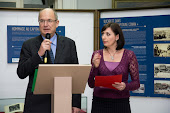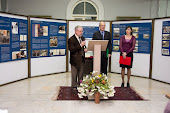The travelling photo-documentary exhibition „Homage to Captain Conan" displayed at the National Museum of History of Moldova is organised by the French Institute of Bucharest in partnership with the National Archives of Romania and the Municipal Library from Dinan (France) commemorating the beginning of World War I.
The exhibition invites everyone to discover one of the symbolic novels of World War I: „Captain Conan" written by French writer Roger Vercel (Goncourt Prize laureate in 1934) who fought on the Eastern front.
Mobilised in 1914, then sent to the Eastern front in 1918, Roger Vercel fought against Bulgaria, marched in Bucharest on Armistice Day, fought with Bolsheviks in Bessarabia and was the rapporteur of the War Council before his return to France. The months spent in Central and Eastern Europe marked him deeply and inspired in writing three novels: „Our ancestor Traian", „Captain Conan" and „Léna". The novel „Captain Conan" is the story of French soldiers mobilised to fight the war against the Bolsheviks. With barracks in Bucharest, they have difficulties in complying with the laws of civil life in Romania. With this novel, Roger Vercel offers a picture of events in the country at the end of the war, the relations between the Romanian population, barely freed from German occupation, and French soldiers who cannot return to the motherland.
The exhibition tells the story of the novel, from the moment of its writing to Bertrand Tavernier's film adaptation in 1996, based on Dinan Municipal Library archives. Also, the exhibition sends us in Roger Varcel's Bucharest of 1918-1919 years, due to descriptions and documentations made in collections of the National Archives of Romania. The reproductions of photos that represent Vercel in his homeland along with different French personalities, arranged on eight stands, are combined with illustrated postcards from the National Archives of Romania depicting aspects of city life described by the French author in his book.
The display is complemented with original pieces from World War I - photos, newspapers, postcards, prints, weapons, etc. - held in the collections of the National Museum of History of Moldova and private collections.
The exhibition is accompanied by the screening of "Capitaine Conan" directed by Bertrand Tavernier.
 31 August 1989 St., 121 A, MD 2012, Chisinau, Republic of Moldova
31 August 1989 St., 121 A, MD 2012, Chisinau, Republic of Moldova

























































